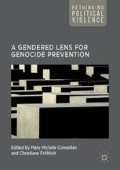Abstract
An understanding of gender and the ways in which gender is performed is central to achieving effective, long-term, humanist mechanisms for genocide prevention. This book develops the concept of “a gendered lens for genocide prevention,” providing innovative and effective ways in understanding the role of gender in genocide studies, and new tools for policymaking and preventative efforts. A gendered lens for genocide prevention is based on recognizing early warning signs of preconditioned behavior for perpetrating genocide and mass atrocities.
While gender has been recognized as a crucial factor in understanding genocide and mass atrocities, most notably in the work of Adam Jones, a specific gendered lens for genocide prevention remains to be lacking in both policy and academia. To provide a framework for a gendered lens for genocide prevention, the authors draw on contemporary feminist theory, concepts of masculinity, critical discussions of international law and in-depth case studies. The authors uncover socially constructed gender roles for the onset, form and prevention of genocide and mass atrocities.
The framework is applied to a diverse range of topics, covering historic cases of genocide and its treatment by international law, for instance the Holocaust, the Red Khmer and Rwanda, and also contemporary cases like mass atrocities committed against Yazidis in Iraq and Syria.
The book does not attempt to offer a single or particular solution to preventing genocide and mass atrocities, but rather highlights the fact that it is prevention that should be at the forefront of both academic work and political initiatives. The editors propose that any future work on genocide and mass atrocity prevention should involve a better understanding of how gendered roles interact with violence at different stages, and how working with this knowledge can assist prevention efforts.
Access this chapter
Tax calculation will be finalised at checkout
Purchases are for personal use only
Notes
- 1.
Adam Jones (ed.). Gendercide and genocide (Nashville: Vanderbilt University Press, 2004), and Adam Jones, “Gendercide: Examining gender-based crimes against women and men,” Clinics in Dermatology 31: 2 (2013): 226.
- 2.
Tom Cushman, “Is genocide preventable? Some theoretical considerations,” Journal of Genocide Research 5:4 (2003): 523.
- 3.
Henry Theriault, “Against the grain: Critical reflections on the state and future of genocide scholarship,” Genocide Studies and Prevention 7:1 (2012): 124f.
- 4.
Ibid.
- 5.
See Cushman, “Genocide,” 524.
- 6.
See Christiane Fröhlich and Giovanna Gioli, “Gender, conflict and global environmental change.” Peace Review – A Journal of Social Justice 27: 2 (2015).
- 7.
Cushman, “Genocide,” 524.
- 8.
Ibid.
- 9.
Theriault, “Against the grain,” 125.
- 10.
Jones, “Gendercide,” 227.
- 11.
Mary Anne Warren, Gendercide: The implications of sex selection (Totowa, NJ: Rowman & Allanheld, 1985): 22.
- 12.
Jones, “Gendercide,” 227.
- 13.
For example the UN Office for the Special Advisor on Genocide Prevention.
- 14.
Gregory H. Stanton originally presented as a briefing paper, “The Eight Stages of Genocide” at the US State Department in 1996. Discrimination and Persecution have since been added to the 1996 model. See, http://www.genocidewatch.org/genocide/tenstagesofgenocide.html.
- 15.
Anna Kaijser and Annica Kronsell, “Climate change through the lens of intersectionality.” Environmental Politics 23: 3 (2013): 419.
- 16.
For instance K Crenshaw, “Mapping the margins: Intersectionality, identity politics, and violence against women of color,” Stanford Law Review 43:6 (1991), and Pinar Bilgin, Identity/Security (The Routledge Handbook of New Security Studies, ed. by J. P. Burgess, Routledge, 2010).
- 17.
Gabriele Winker and Nina Degele, “Intersectionality as multi-level analysis: Dealing with social inequality,” European Journal of Women’s Studies 18:1 (2011): 51.
References
Bilgin, Pinar. Identity/Security. The Routledge Handbook of New Security Studies, (edited by) J. P. Burgess. London and New York: Routledge, 2010, pp. 81–89.
Crenshaw, Kimberlé. “Mapping the margins: Intersectionality, identity politics, and violence against women of color.” Stanford Law Review 43:6 (1991), 1241–1299.
Cushman, Tom. “Is genocide preventable? Some theoretical considerations.” Journal of Genocide Research 5:4 (2003), 523–542.
Fröhlich, Christiane, and Giovanna Gioli. “Gender, conflict and global environmental change.” Peace Review – A Journal of Social Justice 27:2 (2015), 127–136.
Jones, Adam (ed.). Gendercide and Genocide. Nashville: Vanderbilt University Press, 2004.
Jones, Adam. “Gendercide: Examining gender-based crimes against women and men.” Clinics in Dermatology 31:2 (2013), 226–229.
Kaijser, Anna, and Annica Kronsell “Climate change through the lens of intersectionality.” Environmental Politics 23:3 (2013), 417–433.
Theriault, Henry. “Against the grain: Critical reflections on the state and future of genocide scholarship.” Genocide Studies and Prevention 7:1 (2012), 123–144.
Warren, Mary Anne. Gendercide: The Implications of Sex Selection. Totowa, NJ: Rowman & Allanheld, 1985.
Winker, Gabriele, and Nina Degele “Intersectionality as multi-level analysis: Dealing with social inequality.” European Journal of Women’s Studies 18:1 (2011), 51–66.
Author information
Authors and Affiliations
Corresponding author
Editor information
Editors and Affiliations
Copyright information
© 2018 The Author(s)
About this chapter
Cite this chapter
Connellan, M.M., Fröhlich, C. (2018). A Gendered Lens for Genocide Prevention. In: Connellan, M., Fröhlich, C. (eds) A Gendered Lens for Genocide Prevention. Rethinking Political Violence. Palgrave Macmillan, London. https://doi.org/10.1057/978-1-137-60117-9_1
Download citation
DOI: https://doi.org/10.1057/978-1-137-60117-9_1
Published:
Publisher Name: Palgrave Macmillan, London
Print ISBN: 978-1-137-60116-2
Online ISBN: 978-1-137-60117-9
eBook Packages: Political Science and International StudiesPolitical Science and International Studies (R0)

